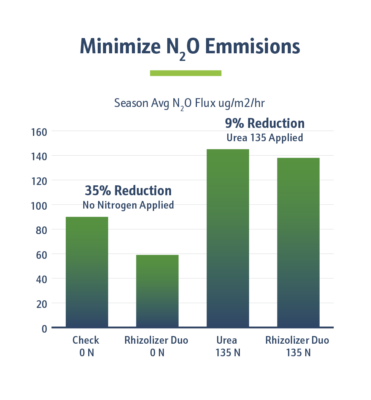
How Biologicals Prevent Nitrogen Loss and Boost Crop Yields
“Go Make Bread Out of Air”
Article provided by Locus AG lead agronomist, David Dyson
During the turn of the twentieth century, chemists Fritz Haber and Carl Bosch created a way of extracting nitrogen from the air and using it to make a stunningly good fertilizer. Quoting one of my favorite books, The Alchemy of Air by Thomas Hager, “They discovered a way to make bread out of air.” That stunningly good fertilizer was fixable nitrogen from the N2 in the atmosphere.
Converting nitrogen to a form usable to plants is a difficult process. Unfortunately, losing nitrogen to the environment isn’t as difficult, and can be as common as a rain event or the sun shining.
This blog shares:
- 3 key ways excess nitrogen is lost in agriculture
- How the use of agricultural biologicals can reduce nitrogen loss
3 Key Ways Excess Nitrogen is Lost
Nitrogen can leave the root zone and get lost to the surrounding environment in three main processes: leaching, ammonia volatilization, or denitrification.

1. Leaching is when excess nitrate escapes the root zone and becomes an environmental and human hazard. This process can contaminate surface water and is a major contributor to the low-oxygen “Dead Zone” in the Gulf of Mexico. Leaching can also contaminate ground water, leading to “Blue Baby Syndrome.” (If drinking water contains too much nitrogen, the nitrogen can replace the oxygen in the blood causing skin to turn blue to anyone who ingests it. This affects smaller children at a higher rate, hence the name.)
2. Ammonia volatilization is when ammonium from fertilizer is converted to ammonia gas and returns to the atmosphere. This can occur if UAN or dry urea fertilizer is applied to the surface of the ground, through the urease process. Sidedress and Y-drop season is quickly approaching. Sidedress applicators apply UAN with a rolling cutter; this nitrogen application uses less power and does not disturb the soil very much. Unfortunately, rolling cutters and Y-drops leave the UAN exposed and subject to ammonia volatilization.
3. Denitrification occurs when nitrate is converted into a gas and escapes into the atmosphere. This usually happens after a major rain event when the soil becomes temporarily saturated. The nitrogen you apply to the ground will convert to nitrate and either be taken up by the plant or, if the soil is saturated, the nitrogen will transform into nitrogen gas (N2O) and escape. Unfortunately, you’ll witness your expensive source of nitrogen bubble up and float away and your yields start to decrease.
Biologicals Proven to Reduce Nitrogen Loss
The good news is – there is something that can be done to reduce nitrogen loss on your farm.
Locus Agriculture teamed up with the University of Illinois for a 2-year trial of their biological product, Rhizolizer Duo. Researchers tested whether applying Rhizolizer Duo at corn planting reduced the amount of greenhouse gases N2O and CO2 emitted from the soil.

As shown in the attached chart, the results were positive. Rhizolizer Duo applied at time of planting resulted in a reduction in greenhouse gases. The microbes in Rhizolizer Duo BA for corn led to bigger roots and more vigorous plants, which absorbed more nutrients and resulted in less nitrogen converted to N2O.
What This Means for You
It is possible for you to protect your investment in nitrogen, your potential yield, and the environment. Applying Locus AG’s Rhizolizer Duo at planting:
- Prevents nutrients from leaving the root zone
- Increases yield by increasing nutrient availability to the crop
READ MORE: How Biologicals Unlock Unused Nutrients in Your Soil
Get Started with Locus AG Biologicals Today
Locus AG has crop-specific biological products for a variety of row and specialty crops. Contact your local Locus AG rep to learn more about how these products can prevent nitrogen loss and benefit your cropping system.
Want to learn how Locus AG vital biologicals can increase your yields and profits?
Fill out the form below and one of our agricultural experts will be in touch.



